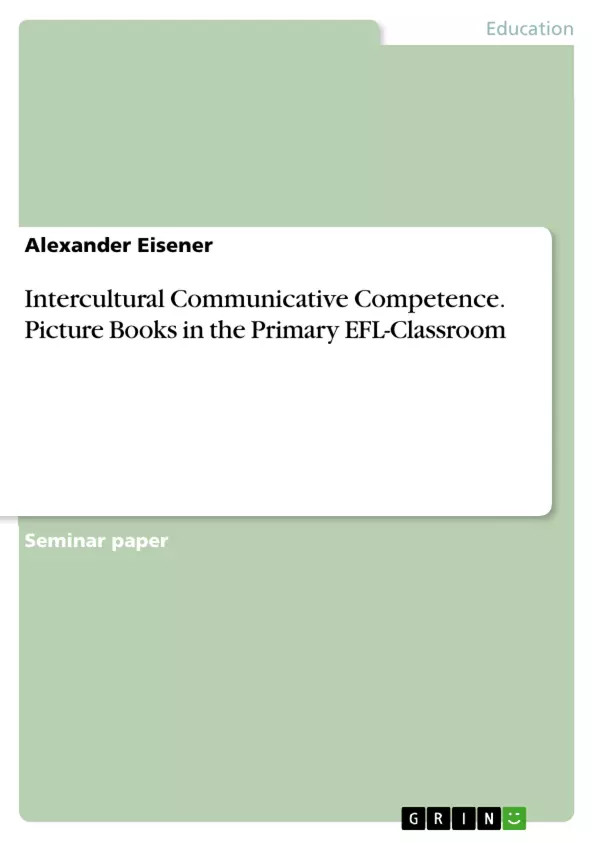In this work the author analyses the usage of a picture book as a key to develop intercultural communicative competence in primary schools with an "English as a foreign language"-setting.
In the paper at hand, the approach is rather humanistic and based on literature studies. It serves for a broad introduction into the relations of culture and education and is structured in the following way: First, we will define the terms culture and ICC more closely. A lot of details will deal with what ICC is about. Then, I present two examples of greater out-groups which have to face prejudices. The next point will deal with the connection of ICC and the primary school, which is followed by the link of ICC with picture books. Moreover, there is a detailed analysis of Joanna Troughton's "The Tiger Child" in relation to the given context. Last but not least, a creative teaching idea for a couple of lessons, thematising "The Tiger Child", is presented, and the work is ended with a compact conclusion. Among the most important resources are the Byram (1997) work, books of facts like the Enc. Britannica and the seminar slides.
To begin with, we have to clarify what culture means. The Oxford English Dictionary (2006) speaks of culture as the arts and other instances of human intellectual achievement regarded as a whole; refined understanding or appreciation of this; or the art, customs, ideas, and social behaviour of a nation, people, or group. The "Pyramid of mental programming" model by Hofstede & Hofstede (2005) specifies culture as specific to a group or category - a learned field or dimension-lying on a basis called "human nature" which is universal and inherited. "Personality" forms the top of this pyramid as something which is specific to the individual and learned but also inherited.
Inhaltsverzeichnis (Table of Contents)
- Introduction
- The terms 'culture' and ‘ICC’
- The importance of ICC in general
- Stereotypes regarding two example out- groups
- ICC and the primary school
- ICC and picture books
- The term 'picture book'
- Picture books as a key for learning ICC
- “The Tiger Child”
- Culture within “The Tiger Child”
- Karma and caste
- Teaching idea
- Culture within “The Tiger Child”
- Conclusion
Zielsetzung und Themenschwerpunkte (Objectives and Key Themes)
This work aims to explore the use of picture books as a tool for developing intercultural communicative competence (ICC) in primary school classrooms with an ‘English as a Foreign Language’ setting. The paper uses a humanistic approach based on literature studies to provide a comprehensive overview of the relationship between culture and education.
- Defining and clarifying the concepts of 'culture' and 'ICC'
- Examining the importance of ICC in general and its significance in the primary school context
- Analyzing the role of picture books in fostering ICC
- Investigating specific cultural elements within the picture book “The Tiger Child”
- Presenting a practical teaching idea for incorporating "The Tiger Child" into an EFL lesson plan
Zusammenfassung der Kapitel (Chapter Summaries)
- Introduction: This chapter introduces the concept of intercultural communicative competence (ICC) and its relevance in primary education. It also outlines the structure and purpose of the paper, focusing on the use of picture books to develop ICC.
- The terms 'culture' and 'ICC': This chapter defines the terms "culture" and "ICC" in detail, drawing upon various sources like the Oxford English Dictionary and the "Pyramid of mental programming" model by Hofstede & Hofstede. It also highlights the importance of ICC within the German primary school curriculum.
- The importance of ICC in general: This chapter further examines the concept of ICC, emphasizing its significance in promoting understanding and successful communication across cultures. It explores the challenges posed by stereotypes and prejudice, and emphasizes the importance of fostering open and curious attitudes towards different cultures.
- Stereotypes regarding two example out-groups: This chapter presents examples of two out-groups often facing prejudice, emphasizing the need to address stereotypes and promote understanding.
- ICC and the primary school: This chapter discusses the importance of developing ICC within the primary school context. It explores the relevance of ICC in preparing young learners for an increasingly interconnected world.
- ICC and picture books: This chapter examines the potential of picture books to foster ICC. It defines the term "picture book" and explores its effectiveness as a learning tool for developing intercultural understanding.
- “The Tiger Child”: This chapter analyzes the picture book “The Tiger Child” by Joanna Troughton, focusing on its cultural content and its potential to facilitate ICC development. It specifically examines themes of karma and caste within the story, providing insights into the cultural context of the book.
- Teaching idea: This chapter presents a practical teaching idea for incorporating “The Tiger Child” into a primary school lesson plan, aiming to engage young learners in exploring the cultural themes of the book.
Schlüsselwörter (Keywords)
This paper explores the key themes of intercultural communicative competence (ICC), picture books, primary education, 'English as a Foreign Language' (EFL), cultural understanding, prejudice, stereotypes, "The Tiger Child", karma, caste, and teaching ideas for fostering intercultural awareness in young learners.
- Quote paper
- Alexander Eisener (Author), 2019, Intercultural Communicative Competence. Picture Books in the Primary EFL-Classroom, Munich, GRIN Verlag, https://www.grin.com/document/924434



